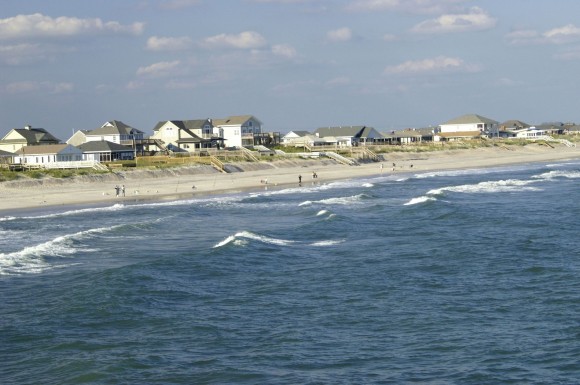Bill Cherry has seen his share of storms buffet his house and his Breezeway Restaurant and Motel near Topsail Beach in North Carolina, a slip of a barrier island just over two blocks wide.
But with sharp increases in premiums for federal flood insurance on the way, he’s willing to now play the odds that it will be some time before the next big storm hits.
He says he will probably self-insure his house on Banks Channel on the mainland side of the island between Wilmington and Jacksonville.
“Hazel was bad and Fran was next, but you’re looking at 50 years between those storms,” he said, discussing the storms that have hit and rising flood insurance costs in the lobby of his motel that was once a military barracks. “You’re better off self-insuring and hope you’re caught up enough so you’re covered” when the next storm hits, he said.
As many as 1.1 million property owners nationwide with subsidized flood insurance face premium increases as the government works to erase a $24 billion shortfall in the flood program. About 17,300 of those policyholders are in North Carolina. In all, there are about 138,000 federal flood policies in effect in the state.
The subsidized insurance helps pay the cost of insurance for homes and businesses in flood zones before there were many rules about building close to the water.
An Associated Press analysis shows that, since the mid-1970s, the program has paid more than 75,000 claims for about $997 million in North Carolina.
Topsail Beach, with a year-round population of 368 but which blooms to about 10,000 in summer, is in the federal flood zone. About 25 percent of island flood policyholders face sharp rate increases, a total of 289. There are about 1,300 structures in the town, most modest beach bungalows. Over the years, there have been just over 2,100 flood insurance claims in Topsail for which about $21 million was paid out.
President Obama last month signed into law a measure easing the immediate impact of the rate increases, phasing them in over several years. Still, rates would increase 18 percent a year for people whose primary home is in a flood zone and 25 percent for people’s second homes and businesses until reaching a level consistent with their real risk of flooding.
Mayor Howard Braxton says there will be hurt for people who have had properties on the island for years.
“They just cannot afford to pay those sharp increases. They just can’t do it,” he said. “Some of the bills now will be more than what some mortgages are.”
He said some property owners are from off island and rent their houses in the summer to pay the mortgage. Some who planned to retire here may not now be able to afford to do so, he warned.
“Those people may just have to stay with renting or just have to sell,” the mayor added.
Town Manager Tim Holloman said he sees a time when the government will prevent the building back of beachfront homes damaged or destroyed in storms. “I think they are going to try to limit repetitive losses in the future,” he said.
Braxton feels lawmakers are unfairly singling out coastal areas.
“We live down on the beach and they say we can afford it more than other people and that’s not true,” he said. “People down here are paying for their retirement” by renting homes.
Cherry put it another way:
“You hear a lot of people across the country saying we don’t want to pay for insurance for those hurricanes or rivers flooding,” he said. “I say look, we don’t want to pay for tornadoes or mudslides or whatever else across the country. Everybody has their disaster and we have to take care of everybody.”
Was this article valuable?
Here are more articles you may enjoy.



 Allstate Reports $731M in Q1 Pretax Catastrophe Losses
Allstate Reports $731M in Q1 Pretax Catastrophe Losses  JPMorgan Client Who Lost $50 Million Fortune Faces Court Setback
JPMorgan Client Who Lost $50 Million Fortune Faces Court Setback  Dubai Floods Expose Weaknesses to a Rapidly Changing Climate
Dubai Floods Expose Weaknesses to a Rapidly Changing Climate  USAA to Lay Off 220 Employees
USAA to Lay Off 220 Employees 


